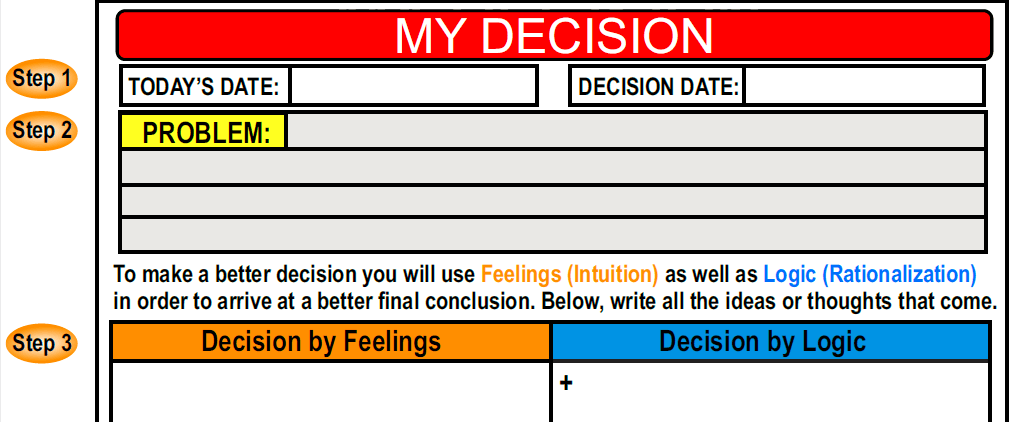Tip#10 – Part 1 – How to Make Better Decisions Under Stress
Lesson 12 Module 1
(Click 3 dots to download MP3)
Sign up below to my Personal Growth newsletter.
Tip#10 is all about how to make better decisions while being under stress. In general, if you are stressed, scared or incredibly confused it is better not to make any decisions at all.
Please understand that in this section I a not referring to crisis like decisions which doctors, firefighters, paramedics and other professional may experience on the job.
The decisions I am referring to are more about your personal life and usually would require you to focus on alternatives before selecting an option.
#1 rule you want to adapt is: the more time you have to make a decision the better.
It will be good If you can wait at least 24h before making a decision, since it is likely you will calm down more during that time or receive extra information.
Wait 1 day – is minimal
Wait 7 days – is okay
Wait 1 month – is good
Wait 3 + months – is excellent
What about last-minute decisions?
I am not removing possible snap judgments from this equation. They will happen. But when they occur, your brain still will be anchoring on whatever facts were present in your mind prior to decision being made.
From my experience it is better to consider all the facts before selecting an option. Thus, identifying variables logically first and then leaving it to intuition to fix any discrepancies is kind of how it works.
Also, remember that people have different personalities and according to MBTI there are 16 personality types. Therefore, everyone will have a bias towards how they make decisions due to their personality being naturally inclined to pick one method over another.
That is why I have created the MY DECISION FORM which will help you to make a better decision in just 10 steps.

Step 1: Write Dates
Write Today’s date and as well as Decision Date which is the time by which you want to have a clear decision.
Step 2: Identify The Problem
Think about the problem/issue you want to solve and try to describe it the best you can, since the words used will have a big impact on how you will approach solutions.
Step 3: Feelings vs. Logic
Look at the left side of the page where it states Decision By Intuition and then right away focus on the problem you have identified. Whatever comes in the next 1-10 seconds is how you feel intuitively about the issue.
Also, as you are filling out the rest of the form some insights might come to you spontaneously, when this happens just go back and add more notes.
In the Decision by
Logic section it is better to use Positives

However, sometimes that may not be the case but the decision can still look enticing and at this point you might consider another alternative. Before going to the next section write down your Answers in all boxes.
Step 4: Alternative Decision
If you are still uncertain, then try to think of an Alternative Decision to your problem. Ask yourself in your head or out loud, Do I have any alternatives?
If the answer is No, then you want to start asking yourself these questions:
- Can I ask somebody?
- Did anybody else solved/accomplished this before?
- Can I do a Google search about this?
- Can I buy a book about it?
- Can I buy a course about it?
When you are confused, what you want to do is to start amplifying the level of information you have to solve the problem.
If you do this enough then you might come up with an Alternative Decision which will be in between the Intuitive and the Logical one, or something totally new.
Step 5: Intuition vs. Alternative vs. Logic
Summarize your decision into one sentence under each decision type (Intuition, Alternative, Logic).
Step 6: Level of Certainty
Look at each final decision you have identified and see how certain you are about it. The level of certainty for a specific decision will determine if you will select it as your final decision to execute. Pick a decision that has over 50% certainty. Usually you would want certainty level to be 75% or higher but even if it is like 58% or 68% you can still select it as long as other choices have a lower certainty level.
Go to next lesson to learn about PART 2 of the MY DECISION FORM.
If you want to contact me, you can do so below.

